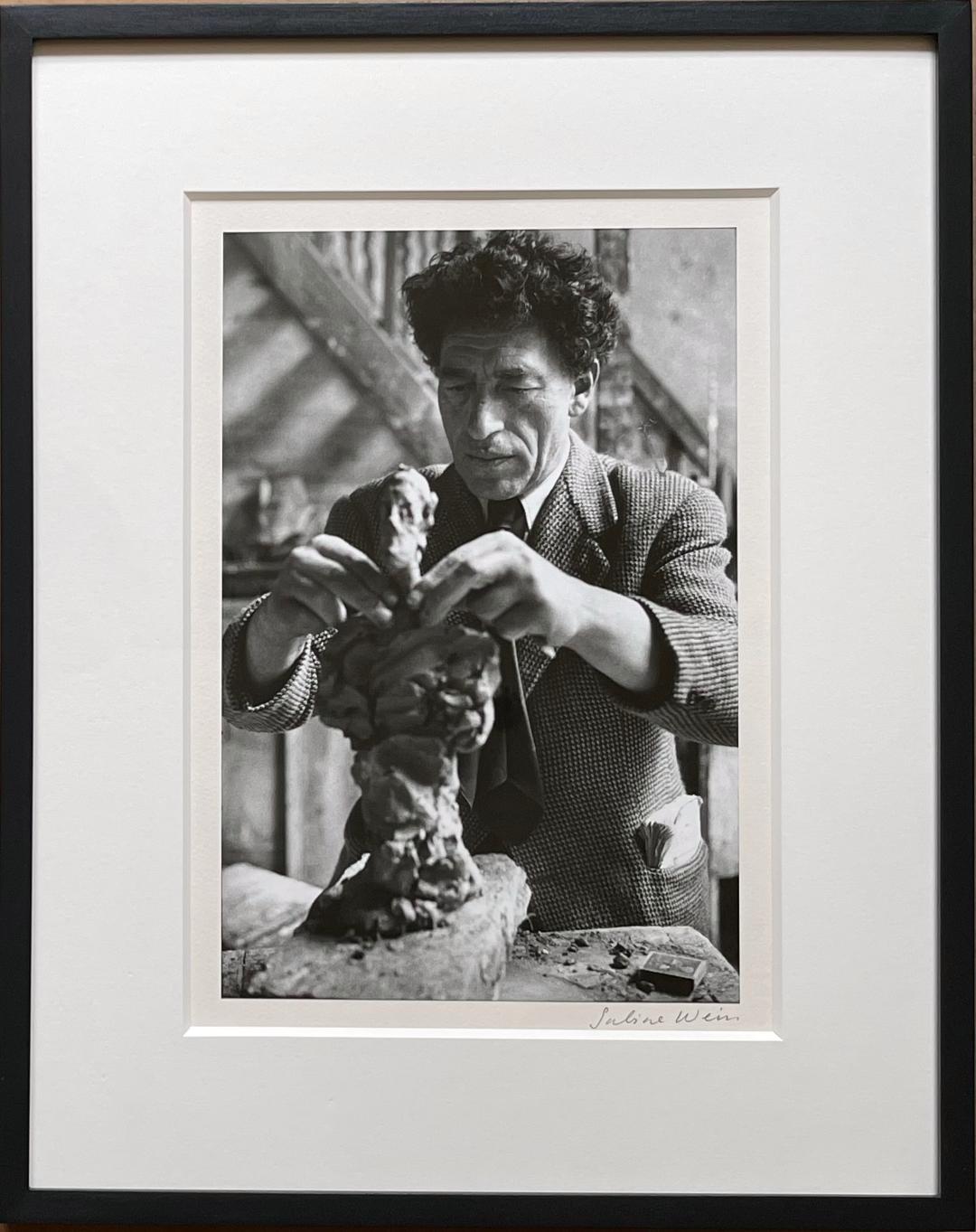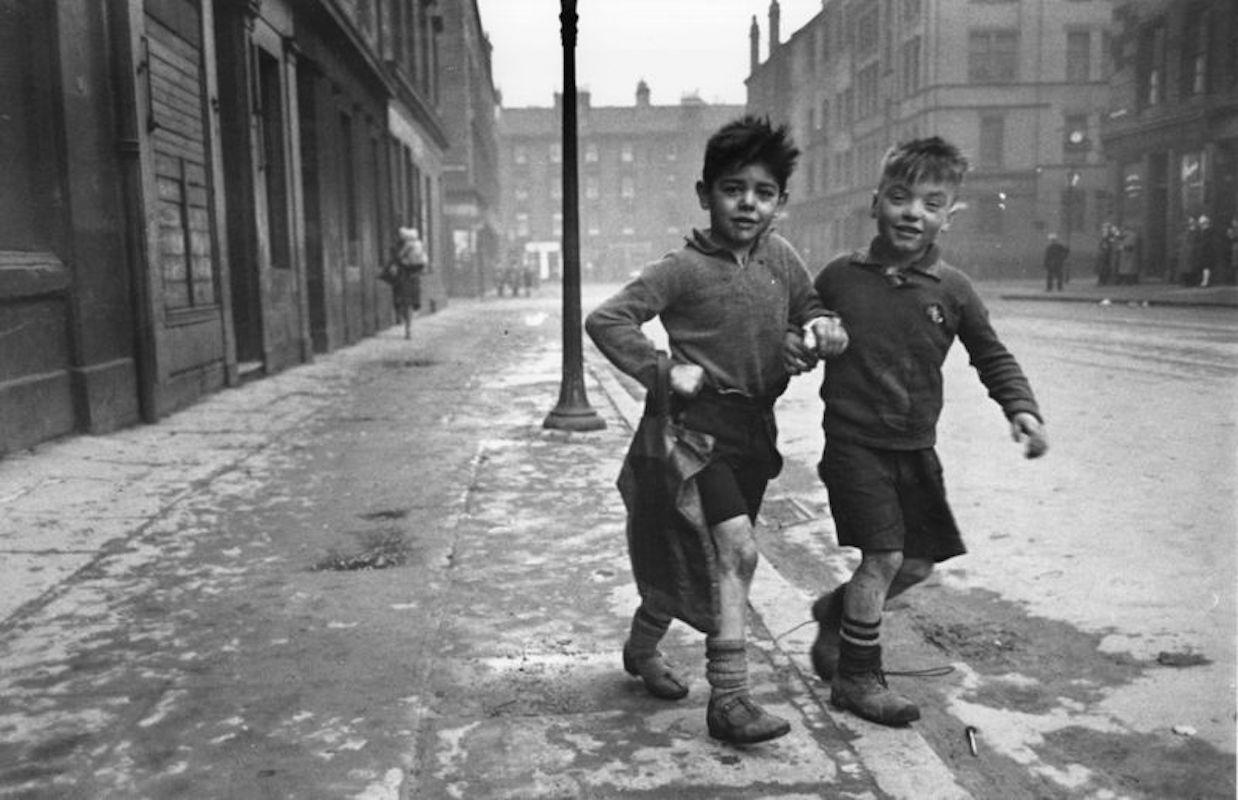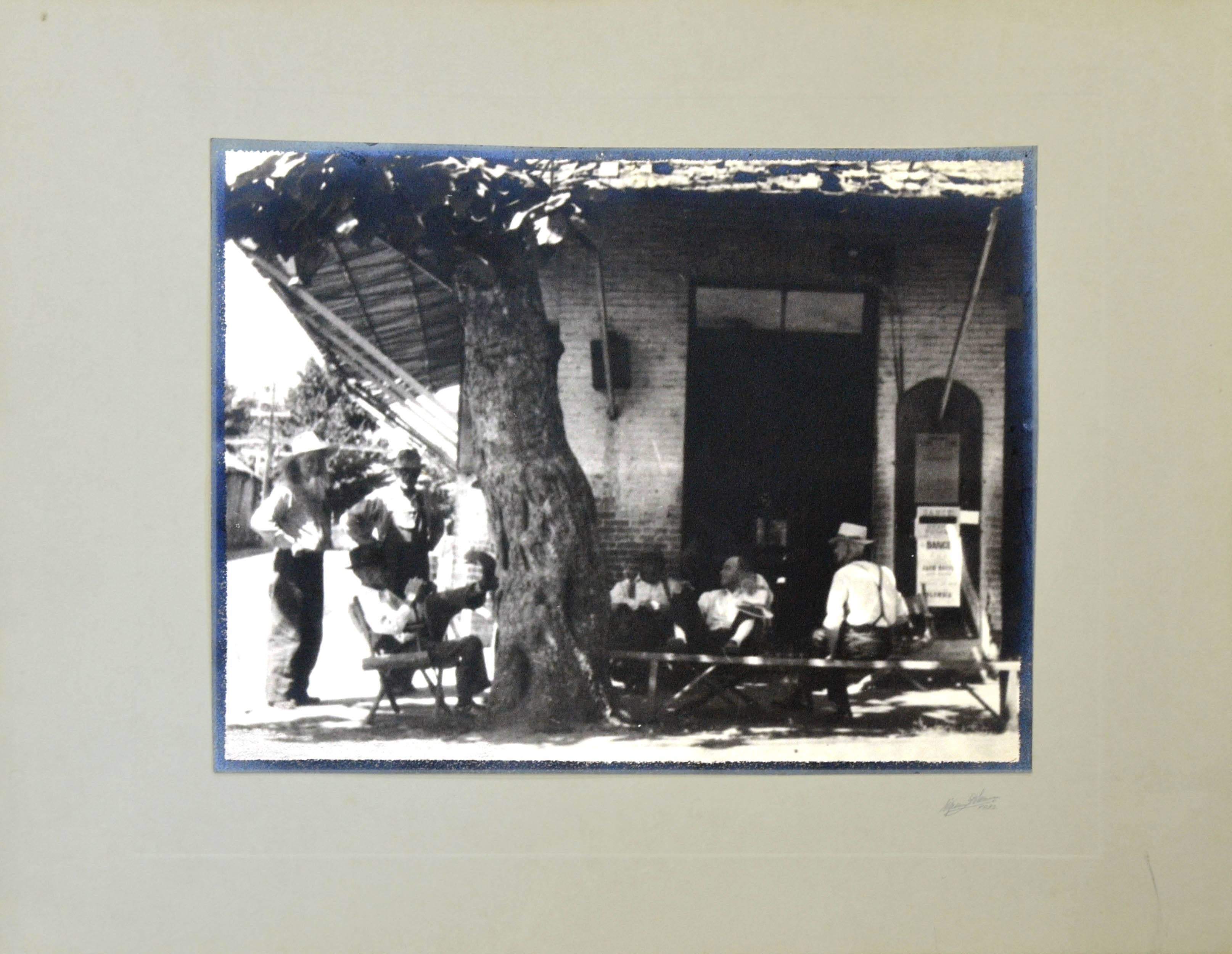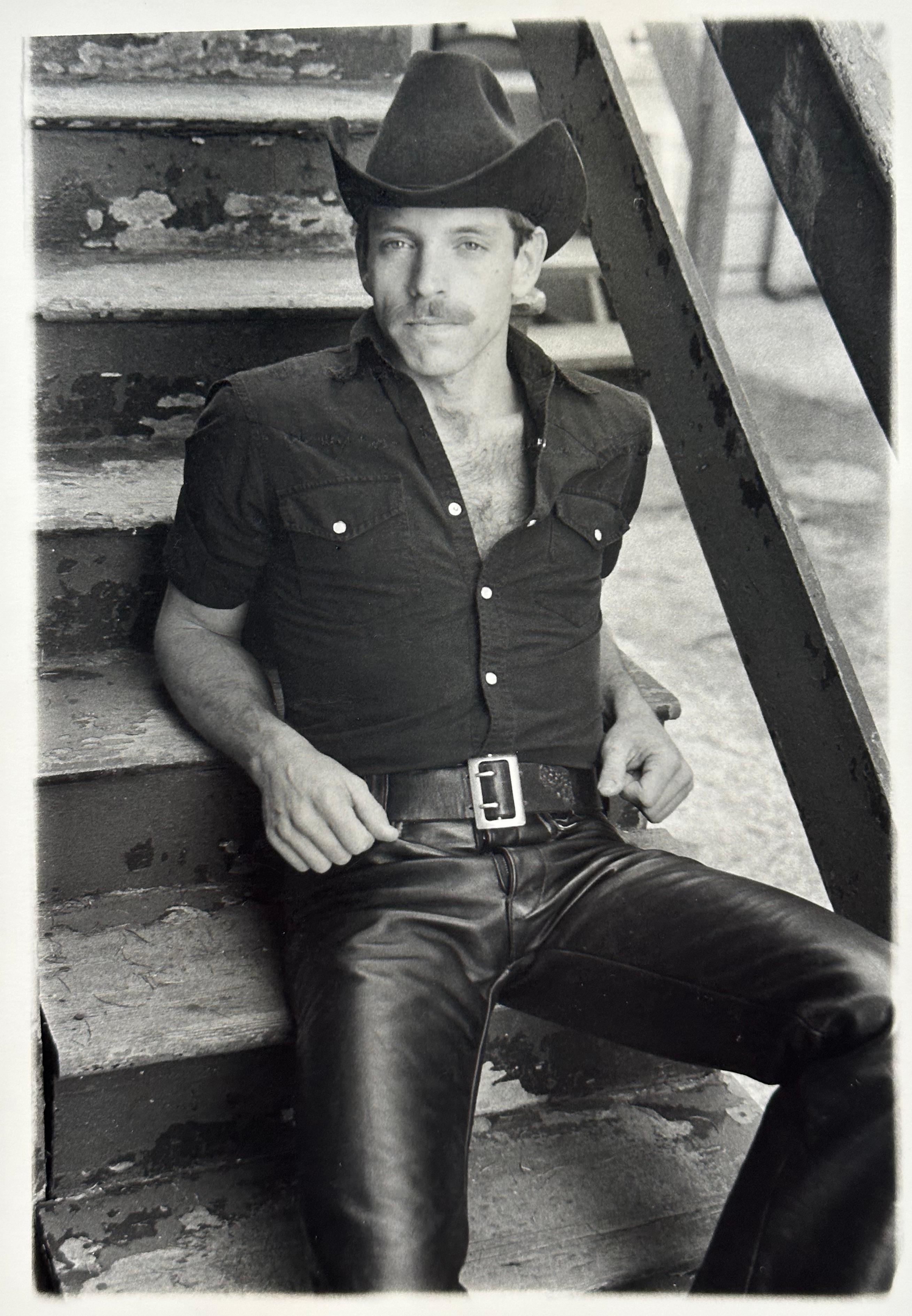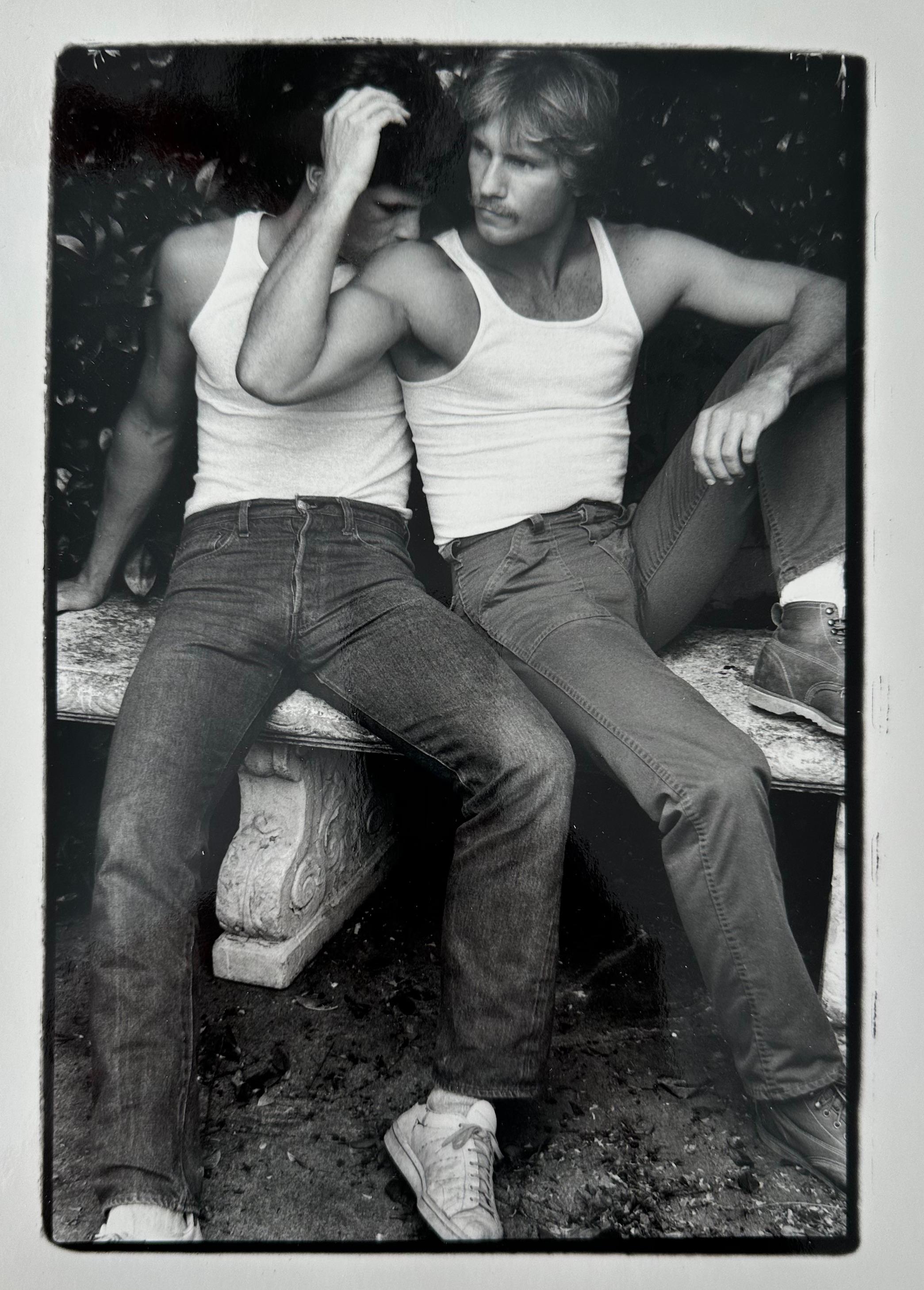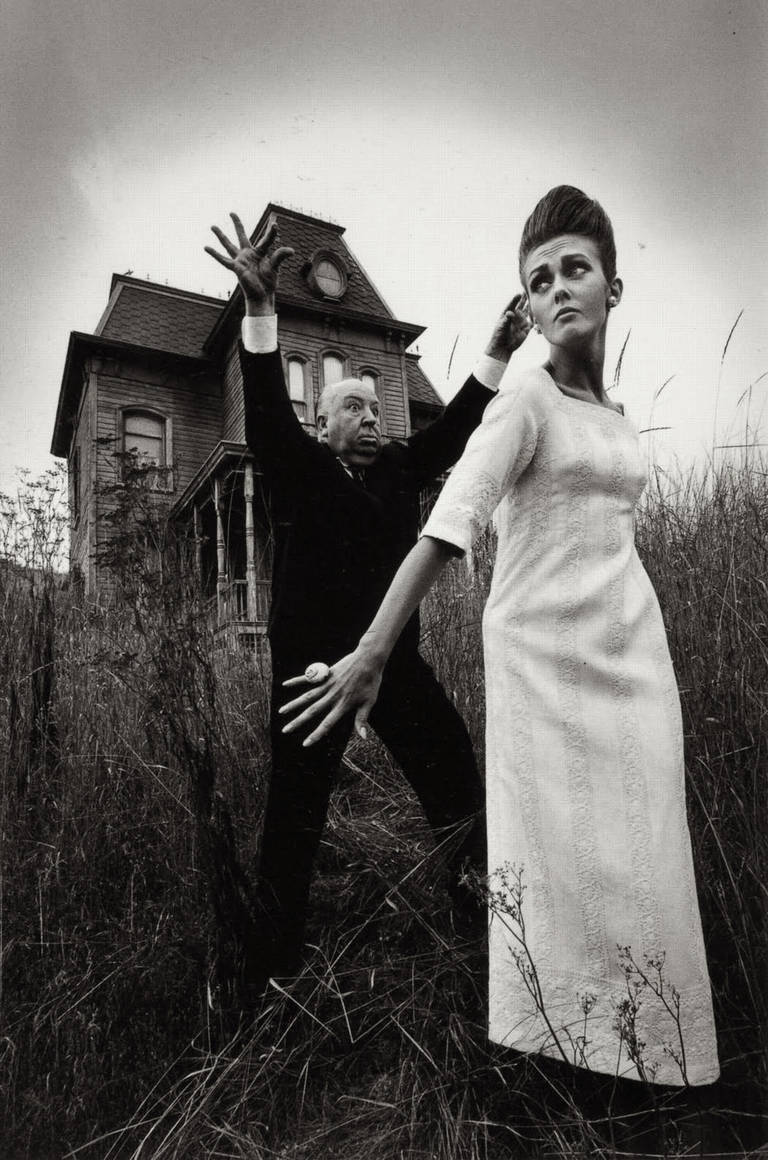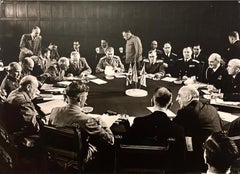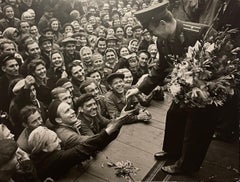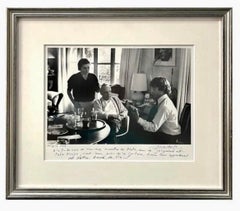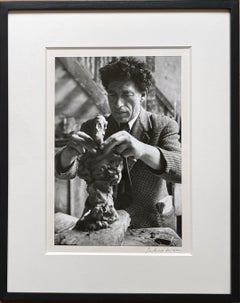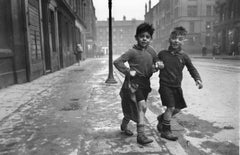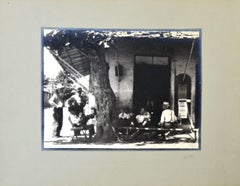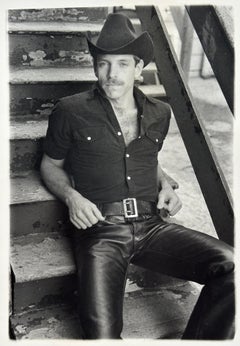Items Similar to Large Silver Gelatin Russian Photograph Potsdam Conference Truman Photo WWII
Want more images or videos?
Request additional images or videos from the seller
1 of 10
Samariy GurariyLarge Silver Gelatin Russian Photograph Potsdam Conference Truman Photo WWII
About the Item
Potsdam conference meeting depicting Josef Stalin, Winston Churchill and Harry Truman on the balcony gelatin silver print, matte finish on photograph, artist's stamp verso, approximately 11" x 15-1/2" sheet, date of printing unknown.
Provenance: acquired from the estate of photographer Samariy Gurariy.
Samariy Gurariy (1916 - 1998) was a Soviet Union photojournalist and photographer. He was born to a Jewish family in Kremenchug Poltavs'ka moving to Moscow in 1921. He began his career in 1934, photographing for the illustration department of the Moscow newspaper Izvestia. He also did work for Pravda, Tass and Gaz. He became the favorite photo correspondent of Stalin and was present and working at many of the most historic events of Stalin's career, such as the Yalta and Potsdam Conferences as well as covering the Soviet-Nazi front during the Second World War. According to writer George Alexander, Gurariy also “. . . photographed Molotov at the opening ceremonies of the United Nations, Khruschev’s historic Moscow meeting with Fidel Castro, Jimmy Carter’s meeting with Leonid Brezhnev and many of the early cosmonauts, including Yuri Gagarin, the first man in space.” The photographer decided to immigrate to the United States after the collapse of the USSR, smuggling a series of photograph prints through Israel along the way before arriving in America in 1995. Today in Russia, he is regarded by photographic historians as the equal of Russian and Ukrainian greats Dmitri Baltermants, Yevgeny Khaldei, Max Alpert and Arkady Shaikhet. Excerpted from “Samariy Gurariy: An Introduction to the Life and Works” by George Alexander
Photography assignments were only given to the most trustworthy party members. The most famous photographer of the pre-war time, “Stalin’s falcon” Alexander Rodchenko, was only photographing “the positive side of reality:” parades and marches, famous people, symbols of time and of the epoch. Even on his trips to the construction site of the White sea channel (Belomorkanal), that, as we all know, was built by prisoners, Rodchenko managed to get happy faces.
In English the spelling of his name is also found as Samari Gurary and Samary Gurari, Shmuel Mikhailovitch Gur-Arye, Samariy Mikhailovich Gurari, Samarii Gurarii. Samariy Mikhailovich (Mikhoel-Leibovich) Gurari ( 1916 -1998) - Soviet photographer, Honored Worker of Culture of the RSFSR. Born on November 1, 1916 in Kremenchug (now Poltava region, Ukraine) in the family of Mikhoel-Leib Gurari (1881-1925). He died on December 7, 1998 in New York where he lived in his last years. Buried in Moscow at the Piskariovskoye cemetery. His vintage archive is represented by Anya Tish Gallery and has been sold at auction by Swann Gallery, Hermitage Fine Art and others.
Awards and recognition
Honored Worker of Culture of the RSFSR .
Order of the Red Star (19.2.1943)
Order of the Patriotic War II degree (6.4.1985);
Order of the Badge of Honor. Moscow encyclopedia. Volume 1: Faces of Moscow. Book 1: AZ. M .: Publishing Center "Moskvovedenie", 2007
- Creator:Samariy Gurariy (1916 - 1998, Russian)
- Dimensions:Height: 11 in (27.94 cm)Width: 15.5 in (39.37 cm)
- Medium:
- Movement & Style:
- Period:
- Condition:good. from photographers archive. minor wear. please see photos.
- Gallery Location:Surfside, FL
- Reference Number:1stDibs: LU38215929222
About the Seller
4.9
Platinum Seller
Premium sellers with a 4.7+ rating and 24-hour response times
Established in 1995
1stDibs seller since 2014
1,742 sales on 1stDibs
Typical response time: 2 hours
- ShippingRetrieving quote...Shipping from: Surfside, FL
- Return Policy
Authenticity Guarantee
In the unlikely event there’s an issue with an item’s authenticity, contact us within 1 year for a full refund. DetailsMoney-Back Guarantee
If your item is not as described, is damaged in transit, or does not arrive, contact us within 7 days for a full refund. Details24-Hour Cancellation
You have a 24-hour grace period in which to reconsider your purchase, with no questions asked.Vetted Professional Sellers
Our world-class sellers must adhere to strict standards for service and quality, maintaining the integrity of our listings.Price-Match Guarantee
If you find that a seller listed the same item for a lower price elsewhere, we’ll match it.Trusted Global Delivery
Our best-in-class carrier network provides specialized shipping options worldwide, including custom delivery.More From This Seller
View AllLarge Silver Gelatin Photograph Russian USSR Soviet Parade Yuri Gagarin Photo
By Samariy Gurariy
Located in Surfside, FL
Yuri Gagarin Meeting Workers at Foundry Stankolit, depicting the famous Russian cosmonaut (Moscow, 1961)
Gelatin silver print, gloss finish, date of printing unknown.
Provenance: acquired from the estate of photographer Samariy Gurariy...
Category
20th Century Realist Black and White Photography
Materials
Silver Gelatin
Large Silver Gelatin Russian Photograph Potsdam Conference Winston Churchill
By Samariy Gurariy
Located in Surfside, FL
Potsdam conference meeting depicting Josef Stalin, Winston Churchill and Harry Truman (not visible) at the conference table, gelatin silver print, date of printing unknown,
16-1/2" x 22-3/4" sheet, date of printing unknown.
Provenance: acquired from the estate of photographer Samariy Gurariy...
Category
20th Century Realist Black and White Photography
Materials
Silver Gelatin
Large Silver Gelatin Photograph Russian USSR Soviet Parade Yuri Gagarin Photo
By Samariy Gurariy
Located in Surfside, FL
Yuri Gagarin Meeting Workers at Foundry Stankolit, depicting the famous Russian cosmonaut (Moscow, 1961)
Gelatin silver print, matte finish, date of printing unknown.
Provenance: acquired from the estate of photographer Samariy Gurariy...
Category
20th Century Realist Black and White Photography
Materials
Silver Gelatin
Silver Gelatin Photograph Hand Signed Photo Pablo Picasso Lucien Clergue
By Lucien Clergue
Located in Surfside, FL
Lucien Clergue (FRENCH, 1934 - 2014)
Gelatin silver photographic print depicting Pablo Picasso titled "Mougins".
Jacqueline et Pablo Picasso écoutant Manitas de Plata, circa 1968.
Hand signed by the artist with hand written description. Titled and dated lower left.
Mounted in a silver painted wooden frame with mat behind acrylic screen.
Paper measures approx. 9" height x 11 1/2" width to sight. Framed measures approx. 14 3/4" height x 17 1/4" width.
Lucien Clergue (French: 1934 – 2014) was a French photographer. He was Chairman of the Academy of Fine Arts, Paris for 2013.
Lucien Clergue was born in Arles, France. At the age of 7 he began learning to play the violin, and after several years of study his teacher admitted that he had nothing more to teach him. Clergue was from a family of shopkeepers and could not afford to pursue further studies in a college or university school of music, such as a conservatory.
In 1949, he learned the basics of photography. Four years later, at a corrida in Arles, he showed his photographs to Spanish painter Pablo Picasso who, though subdued, asked to see more of his work. Within a year and a half, young Clergue worked on his photography with the goal of sending more images to Picasso. During this period, he worked on a series of photographs of travelling entertainers, acrobats and harlequins, the Saltimbanques. He also worked on a series whose subject was carrion. On 4 November 1955 Lucien Clergue visited Picasso in Cannes, France. Their friendship lasted nearly 30 years until Picasso's death. Clergue's autobiographical book, Picasso My Friend, looks back on important moments of their relationship.
In 1968, and with his friend Michel Tournier, Clergue founded the Rencontres d’Arles photography festival which is held annually in July in Arles. He exhibited his work at the festival during the years 1971–1973, 1975, 1979, 1982–1986, 1989, 1991, 1993, 1994, 2000, 2003 and 2007. Clergue also illustrated books, among them a book by writer Yves Navarre.
Clergue took many photographs of the gypsies of southern France, and was instrumental in propelling the guitarist Manitas de Plata to fame. Clergue is perhaps most remembered and respected for his vintage black-and-white studies of light, shadow, and form, featuring sinuous nude female bodies, zebra stripes of light, dynamic sand dunes, and seascapes extracted from the coast of the Camargue. Clergue's photographs are in the collections of numerous well-known museums and private collectors. His vintage photographs have been exhibited in over 100 solo exhibitions worldwide, with noted exhibitions such as in 1961, at the Museum of Modern Art New York, the last exhibition organized by Edward Steichen with Lucien Clergue, Bill Brandt and Yasuhiro Ishimoto. Museums with large collections of his work include The Fogg Museum at Harvard University and the Museum of Fine Arts, Boston. His work, Fontaines du Grand Palais (Fountains of the Grand Palais), is in Museo cantonale d'arte [de] of Lugano. His photographs of Jean Cocteau are on permanent display at the Jean Cocteau Museum in Menton, France. In the U.S., an exhibition of the Cocteau photographs was premiered at Westwood Gallery, New York City. In 2007, the city of Arles honored Lucien Clergue and dedicated a retrospective collection of 360 of his photographs dating from 1953 to 2007. He also received the 2007 Lucie Award.
He was named Knight of the Légion d'honneur in 2003 and elected member of the Academy of Fine Arts of the Institute of France on 31 May 2006, at the same time as a new section dedicated to photography was created. Clergue was the first photographer to enter the Academy to a position devoted specifically to photography.
He was Chairman of the Academy of Fine Arts for 2013.
Lucien Clergue was married to the art curator Yolande Clergue, founder of The Fondation Vincent van Gogh Arles. He was the father of two daughters: Anne Clergue, a curator of contemporary art who has worked at Leo Castelli Gallery, and Olivia Clergue, a handbag fashion designer whose godfather was Pablo Picasso.
Pablo Picasso (1881 –1973) was a Spanish painter, sculptor, printmaker, ceramic artist and theatre designer who spent most of his adult life in France. Regarded as one of the most influential artists of the 20th century, he is known for co-founding the Cubist movement, the invention of constructed sculpture, the co-invention of collage, and for the wide variety of styles that he helped develop and explore. Among his most famous works are the proto-Cubist Les Demoiselles d'Avignon (1907), and Guernica (1937), a dramatic portrayal of the bombing of Guernica by German and Italian air forces during the Spanish Civil War. After 1906, the Fauvist work of the slightly older artist Henri Matisse motivated Picasso to explore more radical styles, beginning a fruitful rivalry between the two artists, who subsequently were often paired by critics as the leaders of modern art. In 1897, his realism began to show a Symbolist influence, for example, in a series of landscape...
Category
20th Century Modern Black and White Photography
Materials
Silver Gelatin
Silver Gelatin Photograph Hand Signed Photo Pablo Picasso Arles Lucien Clergue
By Lucien Clergue
Located in Surfside, FL
Lucien Clergue (FRENCH, 1934 - 2014)
Gelatin silver photographic print depicting Pablo Picasso
Picasso Après la Corrida, Arles, 1962.
Hand signed by the artist and numbered 4/30 (edition of 30) to lower left in ink. Mounted in a silver painted wooden frame with mat behind acrylic screen. Paper measures approx. 10 1/2" height x 7 1/2" width to sight. Measures approx. 16" height x 13 1/4" width
Hand signed by the artist with hand written description. Titled and dated lower left.
Mounted in a silver painted wooden frame with mat behind acrylic screen.
Paper measures approx. 11 3/4" height x 9" width to sight. Framed measures approx. 17 1/4" height x 14 3/4" width.
Lucien Clergue (French: 1934 – 2014) was a French photographer. He was Chairman of the Academy of Fine Arts, Paris for 2013.
Lucien Clergue was born in Arles, France. At the age of 7 he began learning to play the violin, and after several years of study his teacher admitted that he had nothing more to teach him. Clergue was from a family of shopkeepers and could not afford to pursue further studies in a college or university school of music, such as a conservatory.
In 1949, he learned the basics of photography. Four years later, at a corrida in Arles, he showed his photographs to Spanish painter Pablo Picasso who, though subdued, asked to see more of his work. Within a year and a half, young Clergue worked on his photography with the goal of sending more images to Picasso. During this period, he worked on a series of photographs of travelling entertainers, acrobats and harlequins, the Saltimbanques. He also worked on a series whose subject was carrion. On 4 November 1955 Lucien Clergue visited Picasso in Cannes, France. Their friendship lasted nearly 30 years until Picasso's death. Clergue's autobiographical book, Picasso My Friend, looks back on important moments of their relationship.
In 1968, and with his friend Michel Tournier, Clergue founded the Rencontres d’Arles photography festival which is held annually in July in Arles. He exhibited his work at the festival during the years 1971–1973, 1975, 1979, 1982–1986, 1989, 1991, 1993, 1994, 2000, 2003 and 2007. Clergue also illustrated books, among them a book by writer Yves Navarre.
Clergue took many photographs of the gypsies of southern France, and was instrumental in propelling the guitarist Manitas de Plata to fame. Clergue is perhaps most remembered and respected for his black-and-white studies of light, shadow, and form, featuring sinuous nude female bodies, zebra stripes of light, dynamic sand dunes, and seascapes extracted from the coast of the Camargue. Clergue's photographs are in the collections of numerous well-known museums and private collectors. His vintage photographs have been exhibited in over 100 solo exhibitions worldwide, with noted exhibitions such as in 1961, at the Museum of Modern Art New York, the last exhibition organized by Edward Steichen with Lucien Clergue, Bill Brandt and Yasuhiro Ishimoto. Museums with large collections of his work include The Fogg Museum at Harvard University and the Museum of Fine Arts, Boston. His work, Fontaines du Grand Palais (Fountains of the Grand Palais), is in Museo cantonale d'arte [de] of Lugano. His vintage photographs of Jean Cocteau are on permanent display at the Jean Cocteau Museum in Menton, France. In the U.S., an exhibition of the Cocteau photographs was premiered at Westwood Gallery, New York City. In 2007, the city of Arles honored Lucien Clergue and dedicated a retrospective collection of 360 of his photographs dating from 1953 to 2007. He also received the 2007 Lucie Award.
He was named Knight of the Légion d'honneur in 2003 and elected member of the Academy of Fine Arts of the Institute of France on 31 May 2006, at the same time as a new section dedicated to photography was created. Clergue was the first photographer to enter the Academy to a position devoted specifically to photography.
He was Chairman of the Academy of Fine Arts for 2013.
Lucien Clergue was married to the art curator Yolande Clergue, founder of The Fondation Vincent van Gogh Arles. He was the father of two daughters: Anne Clergue, a curator of contemporary art who has worked at Leo Castelli Gallery, and Olivia Clergue, a handbag fashion designer whose godfather was Pablo Picasso.
Pablo Picasso (1881 –1973) was a Spanish painter, sculptor, printmaker, ceramic artist and theatre designer who spent most of his adult life in France. Regarded as one of the most influential artists of the 20th century, he is known for co-founding the Cubist movement, the invention of constructed sculpture, the co-invention of collage, and for the wide variety of styles that he helped develop and explore. Among his most famous works are the proto-Cubist Les Demoiselles d'Avignon (1907), and Guernica (1937), a dramatic portrayal of the bombing of Guernica by German and Italian air forces during the Spanish Civil War. After 1906, the Fauvist work of the slightly older artist Henri Matisse motivated Picasso to explore more radical styles, beginning a fruitful rivalry between the two artists, who subsequently were often paired by critics as the leaders of modern art. In 1897, his realism began to show a Symbolist influence, for example, in a series of landscape paintings rendered in non-naturalistic violet and green tones. What some call his Modernist period (1899–1900) followed. His exposure to the work of Rossetti, Steinlen, Toulouse-Lautrec and Edvard Munch, combined with his admiration for favourite old masters such as El Greco, led Picasso to a personal version of modernism in his works of this period. Picasso made his first trip to Paris, then the art capital of Europe, in 1900. There, he met his first Parisian friend, journalist and poet Max Jacob, who helped Picasso learn the language and its literature. Soon they shared an apartment; Max slept at night while Picasso slept during the day and worked at night. These were times of severe poverty, cold, and desperation. Much of his work was burned to keep the small room warm. In 1907, Picasso joined an art gallery that had recently been opened in Paris by Daniel-Henry Kahnweiler, a German art historian and art collector who became one of the premier French art dealers of the 20th century. He was among the first champions of Pablo Picasso, Georges Braque and the Cubism that they jointly developed. Kahnweiler promoted burgeoning artists such as André Derain, Kees van Dongen, Fernand Léger, Juan Gris, Maurice de Vlaminck and several others who had come from all over the globe to live and work in Montparnasse at the time. Towards the end of World War I, Picasso became involved with Serge Diaghilev's Ballets Russes. Among his friends during this period were Jean Cocteau, Jean Hugo, Juan Gris, and others. In the summer of 1918, Picasso married Olga Khokhlova, a ballerina with Sergei Diaghilev's troupe, for whom Picasso was designing a ballet, Erik Satie's Parade, in Rome; they spent their honeymoon near Biarritz in the villa of glamorous Chilean art...
Category
20th Century Modern Black and White Photography
Materials
Silver Gelatin
Silver Gelatin Photograph Hand Signed Photo Pablo Picasso Profile Lucien Clergue
By Lucien Clergue
Located in Surfside, FL
Lucien Clergue (FRENCH, 1934 - 2014)
Gelatin silver photographic print depicting Pablo Picasso with a frog or turtle.
Mougins, 1968
Hand signed by the artist with hand written description. Titled and dated lower left.
Mounted in a silver painted wooden frame with mat behind acrylic screen.
Paper measures approx. 11 3/4" height x 9" width to sight. Framed measures approx. 17 1/4" height x 14 3/4" width.
Lucien Clergue (French: 1934 – 2014) was a French photographer. He was Chairman of the Academy of Fine Arts, Paris for 2013.
Lucien Clergue was born in Arles, France. At the age of 7 he began learning to play the violin, and after several years of study his teacher admitted that he had nothing more to teach him. Clergue was from a family of shopkeepers and could not afford to pursue further studies in a college or university school of music, such as a conservatory.
In 1949, he learned the basics of photography. Four years later, at a corrida in Arles, he showed his photographs to Spanish painter Pablo Picasso who, though subdued, asked to see more of his work. Within a year and a half, young Clergue worked on his photography with the goal of sending more images to Picasso. During this period, he worked on a series of photographs of travelling entertainers, acrobats and harlequins, the Saltimbanques. He also worked on a series whose subject was carrion. On 4 November 1955 Lucien Clergue visited Picasso in Cannes, France. Their friendship lasted nearly 30 years until Picasso's death. Clergue's autobiographical book, Picasso My Friend, looks back on important moments of their relationship.
In 1968, and with his friend Michel Tournier, Clergue founded the Rencontres d’Arles photography festival which is held annually in July in Arles. He exhibited his work at the festival during the years 1971–1973, 1975, 1979, 1982–1986, 1989, 1991, 1993, 1994, 2000, 2003 and 2007. Clergue also illustrated books, among them a book by writer Yves Navarre.
Clergue took many photographs of the gypsies of southern France, and was instrumental in propelling the guitarist Manitas de Plata to fame. Clergue is perhaps most remembered and respected for his black-and-white studies of light, shadow, and form, featuring sinuous nude female bodies, zebra stripes of light, dynamic sand dunes, and seascapes extracted from the coast of the Camargue. Clergue's photographs are in the collections of numerous well-known museums and private collectors. His vintage photographs have been exhibited in over 100 solo exhibitions worldwide, with noted exhibitions such as in 1961, at the Museum of Modern Art New York, the last exhibition organized by Edward Steichen with Lucien Clergue, Bill Brandt and Yasuhiro Ishimoto. Museums with large collections of his work include The Fogg Museum at Harvard University and the Museum of Fine Arts, Boston. His work, Fontaines du Grand Palais (Fountains of the Grand Palais), is in Museo cantonale d'arte [de] of Lugano. His vintage photographs of Jean Cocteau are on permanent display at the Jean Cocteau Museum in Menton, France. In the U.S., an exhibition of the Cocteau photographs was premiered at Westwood Gallery, New York City. In 2007, the city of Arles honored Lucien Clergue and dedicated a retrospective collection of 360 of his photographs dating from 1953 to 2007. He also received the 2007 Lucie Award.
He was named Knight of the Légion d'honneur in 2003 and elected member of the Academy of Fine Arts of the Institute of France on 31 May 2006, at the same time as a new section dedicated to photography was created. Clergue was the first photographer to enter the Academy to a position devoted specifically to photography.
He was Chairman of the Academy of Fine Arts for 2013.
Lucien Clergue was married to the art curator Yolande Clergue, founder of The Fondation Vincent van Gogh Arles. He was the father of two daughters: Anne Clergue, a curator of contemporary art who has worked at Leo Castelli Gallery, and Olivia Clergue, a handbag fashion designer whose godfather was Pablo Picasso.
Pablo Picasso (1881 –1973) was a Spanish painter, sculptor, printmaker, ceramic artist and theatre designer who spent most of his adult life in France. Regarded as one of the most influential artists of the 20th century, he is known for co-founding the Cubist movement, the invention of constructed sculpture, the co-invention of collage, and for the wide variety of styles that he helped develop and explore. Among his most famous works are the proto-Cubist Les Demoiselles d'Avignon (1907), and Guernica (1937), a dramatic portrayal of the bombing of Guernica by German and Italian air forces during the Spanish Civil War. After 1906, the Fauvist work of the slightly older artist Henri Matisse motivated Picasso to explore more radical styles, beginning a fruitful rivalry between the two artists, who subsequently were often paired by critics as the leaders of modern art. In 1897, his realism began to show a Symbolist influence, for example, in a series of landscape paintings...
Category
20th Century Modern Black and White Photography
Materials
Silver Gelatin
You May Also Like
Alberto Giacometti dans son Atelier, 1954 (Giacometti in his studio)
By Sabine Weiss
Located in New York, NY
Sabine Weiss
Alberto Giacometti dans son Atelier, 1954 (Giacometti in his studio), ca. 1970
Gelatin silver print mounted on paper
Signed in graphite by Sabine Weiss on the mount directly underneath the photograph
Frame Included
This now iconic photograph of Alberto Giacometti in his studio was taken in 1954 by the celebrated photographer Sabine Weiss, who at the time, had unparalleled access to the artist. It was printed ca. 1970 and signed on the mount directly underneath the photograph in a limited edition of an undisclosed size. Highly collectible.
Elegantly matted and framed in a museum quality wood frame with UV plexiglass.
Measurements:
Framed
18 x 14.5 x 1.25 inches
Photograph
12.5 x 8.75 inches
Sabine Weiss biography:
For over sixty years, Sabine Weiss’s name has been synonymous with the seminal era of French Humanist photography. A living legend, Weiss’s images from 1950s Paris speak of a postwar time when a feeling of hope and joie de vivre could be felt in the people populating the city’s cafes, squares, streets, and in all corners throughout Paris. Weiss would photograph individuals going about their daily lives capturing their emotions and creating a style that combined spontaneity and informality, backed by photographer’s intuition and knack for seeing and celebrating the simple joys of life. As she said, “I take photographs to hold on to the ephemeral, capture chance, keep an image of something that will disappear: gestures, attitudes, objects that are reminders of our brief lives. The camera picks them up and freezes them at the very moment that they disappear. I love this constant dialogue between myself, my camera and my subject, which is what differentiates me from certain other photographers, who don’t seek this dialogue and prefer to distance themselves from their subject.”
Originally from Switzerland, Weiss moved to Paris in 1946 where she first assisted fashion photographer Willy...
Category
Mid-20th Century Realist Black and White Photography
Materials
Silver Gelatin
'Gorbals Boys' Bert Hardy Limited Edition Silver Gelatin Fibre Print
By Bert Hardy
Located in London, GB
'Gorbals Boys' (1948)
by Bert Hardy
Limited Edition 44/300
Silver Gelatin Fibre Print
Paper size 10 x 12 inches
Printed later
Two boys in the Gorbals area of Glasgow. The Gorbal...
Category
Mid-20th Century Realist Black and White Photography
Materials
Silver Gelatin
Early 20th Century Photograph -- Sidewalk Club of the Motherlode
By Sigismund Blumann
Located in Soquel, CA
"Sidewalk Club of the Motherlode" a Lithobrome photograh by Sigismund Blumann (American, 1872-1956). Signed "Sigismund Blumann" lower right. Titled "Sidewalk Club of the Motherlode" on verso. Image size, 11.25"H x 13.25"W. Between 1923 and 1932, his pictures were accepted at photographic salons in Amsterdam, Toronto, Rochester, Seattle, and Los Angeles. In 1927, a one-person exhibition of his bromoil prints traveled to camera clubs in Chicago, Akron, Cincinnati, and New York. In addition to bromoil, a process that yields pointillistic images, Blumann utilized such unusual processes as kallitype (Vandyke brown), lithobrome, and pastelograph (the latter two probably his own inventions) to create original photographs using chemical processes he invented.
Sigismund Blumann (1872–1956) (figure 1) was a prominent tastemaker in Californian photography during the 1920s and 1930s. Based in the San Francisco Bay Area for his entire career, he edited magazines, wrote books, and made creative photographs. From 1924 to 1933 Blumann edited Camera Craft, the leading West Coast photographic monthly. Subsequently he established his own periodical, Photo Art Monthly, which he published until 1940. In these two magazines — for over fifteen years — Blumann found a large audience of mainstream pictorial photographers. In addition, he wrote five instructional books on photography...
Category
1920s Realist Black and White Photography
Materials
Photographic Paper, Silver Gelatin
$460 Sale Price
20% Off
Untitled, (Leatherman Cowboy), Castro, San Francisco.
Located in Wilton Manors, FL
Fisher Ross. Untitled, ca. 1975-80. Gelatin Silver print, sheet measures 8 x 10 inches. Artist studio stamp on verso. Good condition with some rippling in ...
Category
1970s Realist Black and White Photography
Materials
Silver Gelatin
$1,050 Sale Price
30% Off
Lovers, San Francisco.
Located in Wilton Manors, FL
Fisher Ross. Untitled, ca. 1975-80. Gelatin Silver print, sheet measures 8 x 10 inches; 17 x 21 inches framed. Artist studio stamp on verso. Excellent cond...
Category
1970s Realist Black and White Photography
Materials
Silver Gelatin
Alfred Hitchcock and Ina, Hollywood, Harper's Bazaar
By Jeanloup Sieff
Located in New York, NY
Alfred Hitchcock and Ina, Hollywood, Harper's Bazaar, 1962
Gelatin Silver Print
image size: 12 x 8 inches
print size: 13 x 9 1/2 inches
signed in pen recto on lower right; photog...
Category
1960s Realist Portrait Photography
Materials
Silver Gelatin
Recently Viewed
View AllMore Ways To Browse
Large Vintage Photo
Vintage Wwii
Vintage Construction Photos
Party Vintage Photos
Vintage Wwii Photos
Vintage Soviet Union
Vintage Harry Winston
Yuri Gagarin
A Goldstein Sculpture
Aboriginal Sculpture
Algeria Map
Allan Houser Prints
Andy Warhol Announcement Card
Antique Nautical Oil Paintings
Apollo Nasa
Artist Talley
Ben Bella
Bronze Balloon
